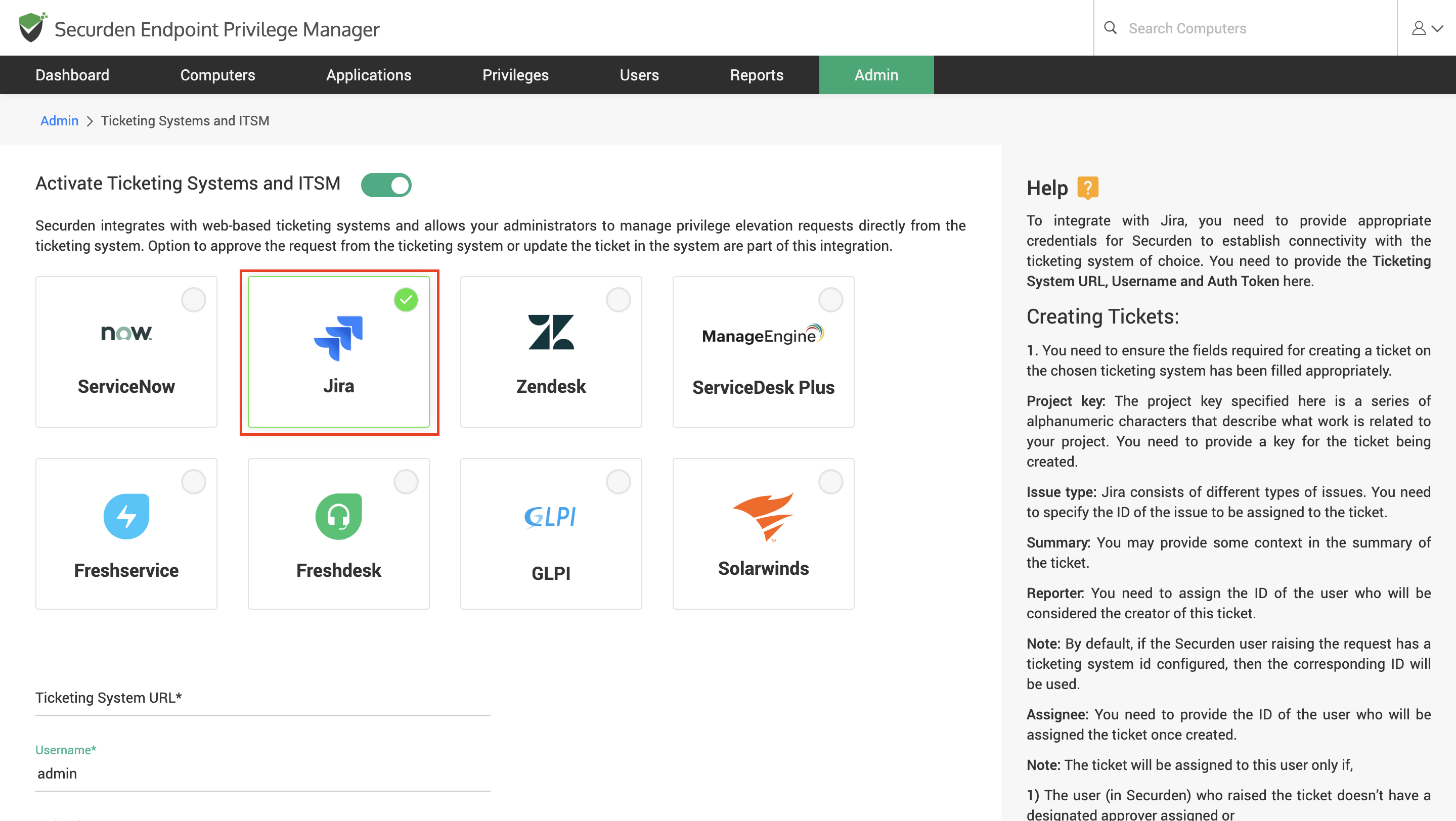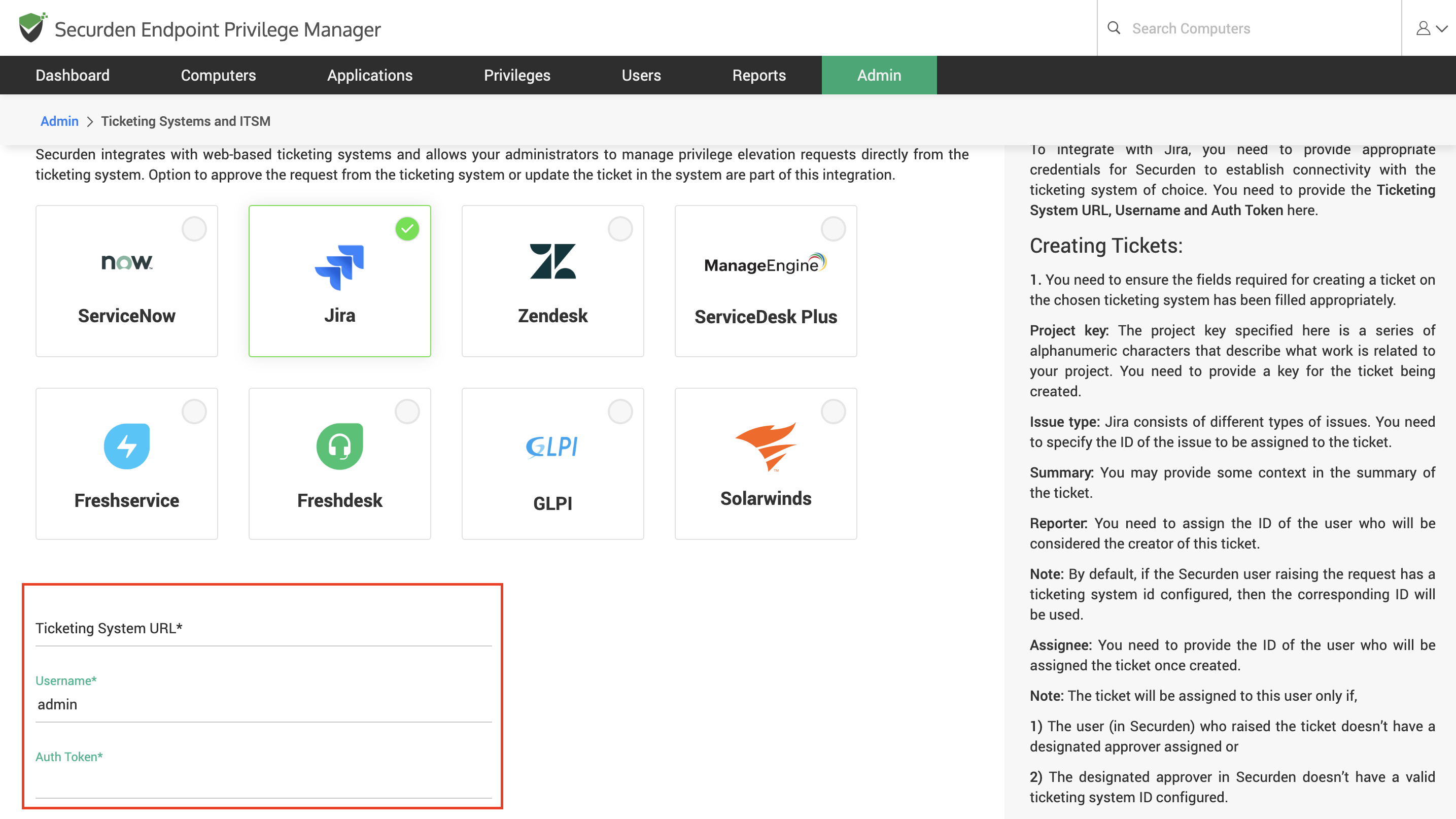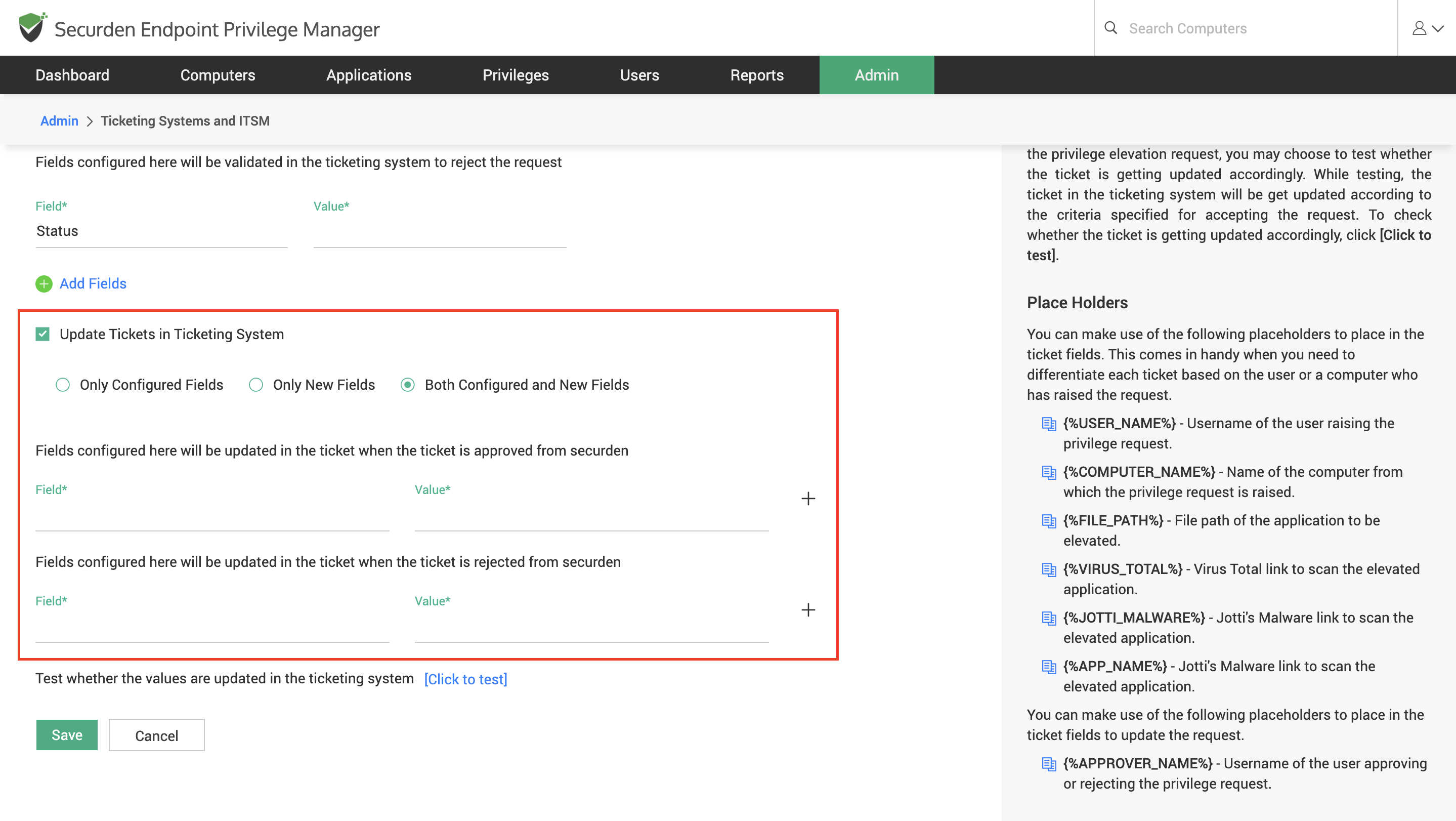How To Manage Requests in Securden EPM Using Jira ITSM?¶
End users place requests to gain application access, and elevated privileges from time to time. The administrator can manage these requests directly from the Securden web interface. In organizations where ticketing systems are in use, the administrator can make use of the ticketing system to approve or reject the requests through integration with the ticketing systems.
Currently, Securden EPM integrates with Jira, ZenDesk, FreshDesk, ServiceNow, Manage Engine ServiceDesk Plus, and GLPI for managing requests.
To start using ITSM solution for managing requests, you need to follow the three steps below.
1) Configure the connectivity between Securden and Jira
2) Configure ticket creation parameters
3) Configure ticket parameters for managing the request
How To Configure Connectivity between Jira ITSM with Securden?¶
To integrate with Jira, you need to provide appropriate credentials for Securden to establish connectivity with the ticketing system of choice. Navigate to Admin >> Integrations >> Ticketing Systems and ITSM and choose Jira from the options displayed.
In this window, you need to provide the following
1) Ticketing System URL
2) Username
3) Auth Token
The URL is used by Securden to communicate with the ITSM solution. The username and authentication tokens are used to authenticate with the Jira ITSM solution.
How to Configure Ticket Creation Parameters in Jira?¶
You can configure the values/parameters to be passed at the time of ticket creation. You need to ensure the fields required for creating a ticket on the chosen ticketing system have been filled appropriately. The following parameters must be specified at the minimum.
Project key – The project key specified here is a series of alphanumeric characters that describe what work is related to your project. You need to provide a key for the ticket being created.
Issue type - Jira consists of different types of issues. You need to specify the ID of the issue to be assigned to the ticket.
Summary - You may provide some context in the summary of the ticket.
Reporter - You need to assign the ID of the user who will be considered the creator of this ticket.
Note
By default, if the Securden user raising the request has a ticketing system id configured, then the corresponding ID will be used.
Assignee - You need to provide the ID of the user who will be assigned the ticket once created.
Important
The ticket will be assigned to this user only if the user (in Securden) who raised the ticket doesn’t have a designated approver assigned or if the designated approver in Securden doesn’t have a valid ticketing system ID configured.
- After filling in the above fields, you have the option to test ticket creation. To create a test ticket, click [Click to Test].
You can also add multiple additional fields by clicking on Add Fields.
Once this is configured, whenever a request is raised in Securden, a corresponding ticket will be created in the ITSM solution.
To manage these requests directly from the ITSM solution, you need to configure the ticket parameters for approving or rejecting the request.
How to Configure Ticket Parameters for Managing the Request?¶
You can use the ticketing system to manage the requests or keep track of activities performed by the helpdesk team. In the first scenario, the ITSM tool will be used to approve or reject the request. In the second scenario, the request will be approved or rejected in Securden and the corresponding change will be reflected in the ITSM solution. You need to configure the ticket parameters that would signal whether the ticket is approved or rejected. Toggle Update Ticket to green and follow the instructions below.
Case 1: The ticket is approved in Jira ITSM
1) You can configure the request to be approved or rejected based on any ticket parameter except Ticket Status.
2) You need to specify the conditions under which the request is approved and rejected separately. You need to specify the field name and the corresponding values here.
3) You have the option to configure a combination of ticket parameters that needs to be checked before the requests are approved or rejected by adding fields and selecting the operator (AND / OR) for evaluating the parameters.
Case 2: The request is approved in Securden
Here, the ticket parameters will be updated according to the preferences when the ticket is approved or rejected from Securden.
1) Select the checkbox named Update Tickets in Ticketing System.
2) You have three options here.
3) When you select the Only Configured Fields option, the fields configured for approving or rejecting requests from the ticketing system will be updated in the ticketing system.
4) On selecting Only New Fields, you can include a fresh field within this section, which will be reflected in the ticketing system upon approval or rejection of requests from the Securden UI.
5) On selecting Both Configured and New Fields, the fields configured within this section and the additional fields configured for approving or rejecting the requests from Securden UI will get displayed in the ticketing system.
Notes
After specifying the criteria for accepting and rejecting the privilege elevation request, you may choose to test whether the ticket is updated accordingly. While testing, the ticket in the ticketing system will be updated according to the criteria specified for accepting the request. To check whether the ticket is getting updated accordingly, click [Click to test].
How to Pass User and Device Attributes as Parameters for Creating and Updating the Ticket?¶
You can make use of the following placeholders to place in the ticket fields to pass user, device, and application details as ticket parameters. This comes in handy when you need to differentiate each ticket based on the user or a computer who has raised the request.
{%USER_NAME%} - Username of the user raising the privilege request.
{%COMPUTER_NAME%} - Name of the computer from which the privilege request is raised.
{%FILE_PATH%} - File path of the application to be elevated.
{%VIRUS_TOTAL%} - Virus Total link to scan the elevated application.
{%JOTTI_MALWARE%} - Jotti's Malware link to scan the elevated application.
{%APP_NAME%} - Jotti's Malware link to scan the elevated application. You can make use of the following placeholders to place in the ticket fields to update the request.
{%APPROVER_NAME%} - Username of the user approving or rejecting the privilege request.
How To Approve and Reject Requests from Jira Interface?¶
Once the integration is configured completely, you can view the corresponding tickets being created in Jira for the requests created in Securden. You can change the ticket attributes in accordance with the rules set in Securden to approve or reject the request.






